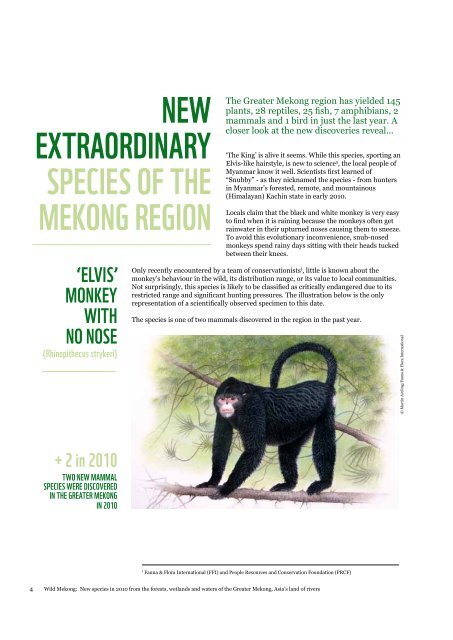Wild Mekong: New species in 2010 from the - WWF
Wild Mekong: New species in 2010 from the - WWF
Wild Mekong: New species in 2010 from the - WWF
Create successful ePaper yourself
Turn your PDF publications into a flip-book with our unique Google optimized e-Paper software.
NEW<br />
EXTRAORDINARY<br />
SPECIES OF THE<br />
MEKONG REGION<br />
‘ELVIS’<br />
MONKEY<br />
WITH<br />
NO NOSE<br />
(Rh<strong>in</strong>opi<strong>the</strong>cus strykeri)<br />
+ 2 <strong>in</strong> <strong>2010</strong><br />
TWO NEW MAMMAL<br />
SPECIES WERE DISCOVERED<br />
IN THE GREATER MEKONG<br />
IN <strong>2010</strong><br />
The Greater <strong>Mekong</strong> region has yielded 145<br />
plants, 28 reptiles, 25 fish, 7 amphibians, 2<br />
mammals and 1 bird <strong>in</strong> just <strong>the</strong> last year. A<br />
closer look at <strong>the</strong> new discoveries reveal...<br />
‘The K<strong>in</strong>g’ is alive it seems. While this <strong>species</strong>, sport<strong>in</strong>g an<br />
Elvis-like hairstyle, is new to science 5 , <strong>the</strong> local people of<br />
Myanmar know it well. Scientists first learned of<br />
“Snubby” - as <strong>the</strong>y nicknamed <strong>the</strong> <strong>species</strong> - <strong>from</strong> hunters<br />
<strong>in</strong> Myanmar’s forested, remote, and mounta<strong>in</strong>ous<br />
(Himalayan) Kach<strong>in</strong> state <strong>in</strong> early <strong>2010</strong>.<br />
Locals claim that <strong>the</strong> black and white monkey is very easy<br />
to f<strong>in</strong>d when it is ra<strong>in</strong><strong>in</strong>g because <strong>the</strong> monkeys often get<br />
ra<strong>in</strong>water <strong>in</strong> <strong>the</strong>ir upturned noses caus<strong>in</strong>g <strong>the</strong>m to sneeze.<br />
To avoid this evolutionary <strong>in</strong>convenience, snub-nosed<br />
monkeys spend ra<strong>in</strong>y days sitt<strong>in</strong>g with <strong>the</strong>ir heads tucked<br />
between <strong>the</strong>ir knees.<br />
Only recently encountered by a team of conservationists I , little is known about <strong>the</strong><br />
monkey’s behaviour <strong>in</strong> <strong>the</strong> wild, its distribution range, or its value to local communities.<br />
Not surpris<strong>in</strong>gly, this <strong>species</strong> is likely to be classified as critically endangered due to its<br />
restricted range and significant hunt<strong>in</strong>g pressures. The illustration below is <strong>the</strong> only<br />
representation of a scientifically observed specimen to this date.<br />
The <strong>species</strong> is one of two mammals discovered <strong>in</strong> <strong>the</strong> region <strong>in</strong> <strong>the</strong> past year.<br />
I Fauna & Flora International (FFI) and People Resources and Conservation Foundation (PRCF)<br />
4 <strong>Wild</strong> <strong>Mekong</strong>: <strong>New</strong> <strong>species</strong> <strong>in</strong> <strong>2010</strong> <strong>from</strong> <strong>the</strong> forests, wetlands and waters of <strong>the</strong> Greater <strong>Mekong</strong>, Asia’s land of rivers<br />
© Mart<strong>in</strong> Avel<strong>in</strong>g/Fauna & Flora International

















